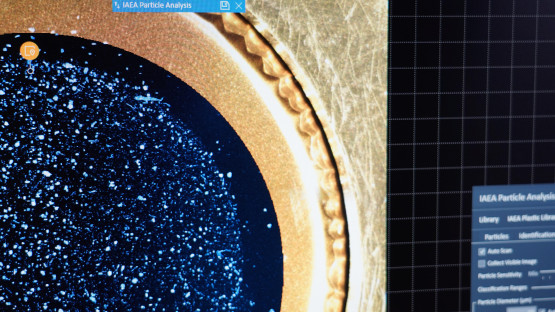A changing climate means a changing ocean. While the full impacts of climate change on the oceans are unclear, studies predict increasing temperatures, rising sea levels and changes to the ocean chemistry, such as ocean acidification, among others. The IAEA supports Member States in using nuclear and isotopic techniques to develop a science-based understanding of changes in the ocean and support climate change monitoring and adaptation activities.
Oceans and climate change
Changes in seawater chemistry are already underway as the ocean takes up about one-fourth of man-made carbon dioxide emitted to the atmosphere each year. Nuclear and isotopic techniques are powerful tools to study the carbon cycle and ocean acidification. They have widely contributed to the understanding of past and current ocean conditions and to predicting the impact of climate change.
Ocean Acidification
As the ocean absorbs carbon dioxide (CO2) released into the atmosphere by human activities, the carbonate chemistry and acidity of seawater is modified in a process known as ocean acidification. While this leaves less carbon dioxide in the atmosphere and substantially limits climate change, ocean acidification, which is sometimes referred to as the “other CO2 problem”, has emerged as a key global issue in the last decade because of its potential to affect marine organisms and biogeochemical cycles.
Nuclear and isotopic techniques are used to study ocean acidification and have widely contributed to the understanding of the field both in terms of investigating past changes in ocean acidity and the impacts of ocean acidification on marine organisms, such as through the study of biological processes like calcification.
Though a decrease in surface ocean pH (“potential of Hydrogen,” a measure of acidity or alkalinity) is already detectable, it is hard to estimate the full impact of ocean acidification on marine biota. Studies show a wide variety of possible impacts, both positive and negative, as different species show different levels of resilience and adaptability.
Below a certain pH and corresponding carbonate concentration, conditions become corrosive to calcium carbonate, which is used by many organisms to build shells and skeletons. Some corals, pteropods, bivalve molluscs and calcifying phytoplankton may be particularly sensitive to changes in seawater chemistry. Energy spent overcoming more acidic conditions may reduce the energy available for physiological processes such as reproduction and growth. Scientists at the IAEA’s Environment Laboratories are using isotopic techniques to investigate the impacts of ocean acidification and its interaction with other environmental stressors.
Studying corals and marine ecosystems
Coral reefs host some of the most diverse ecosystems on the planet, yet studies have shown that some corals are sensitive to variations in their environment. Ocean acidification episodes in the geological past have led to significant changes in ecosystems, including, in extreme cases, mass extinctions of some deep-sea benthic foraminifers (a type of marine organism) and collapse of reef-building calcareous algae and corals.
Because of the potential impact on marine environments and ecosystems, the IAEA’s Environment Laboratories conduct research on topics such as the economic implications of ocean acidification on fisheries. The IAEA also maintains the Ocean Acidification International Coordination Centre, which helps advance ocean acidification science, capacity-building and global communication.
The Agency uses nuclear and isotopic techniques to study the rates of biological processes in marine organisms, such as mussels, oysters and corals. Naturally-occurring boron isotopes can be used to study past changes in seawater pH; scientists measure their relative amounts in coral skeletons formed thousands of years ago in order to assess past seawater acidity. Calcium isotopes are also used to study calcification rates (for the creation of shells and skeletons) and other processes.
Researching the global carbon cycle
The oceans are an important sink for atmospheric carbon dioxide and play a key role in regulating the climate. Carbon dioxide is absorbed by the oceans and can be drawn in and transported by water masses or taken up during photosynthesis and converted into organic matter. Much of this organic matter is recycled in the surface ocean when grazed upon and broken down by zooplankton and microbes. However, a small but important fraction of this material sinks to the deep ocean where it is isolated from the atmosphere for centuries.
This rain of sinking organic matter is an important source of energy for marine organisms further up the food chain. The balance between carbon in the atmosphere and oceans is controlled by the rates of these physical and biological processes. Changes in ocean temperature or chemistry may alter these rates, leading to a shift in the global carbon balance.
The IAEA uses stable and naturally-occurring radioisotopes to look at the sources and fate of organic matter and to understand the oceans’ role in the global carbon cycle. Its Radioecology Laboratory measures the flux of carbon to the deep ocean directly by capturing the material using rain gauge-like sediment traps and indirectly using naturally-occurring radionuclides (thorium-234, uranium-238, polonium-210 and lead-210) that adsorb (adhere) to the sinking material on its path to the seafloor. Applying these tools in a variety of ocean settings such as upwelling zones (where cold, nutrient-rich waters “well up” from below) and the polar oceans helps determine the extent of this sinking flux and evaluate its sensitivity to climate change.







